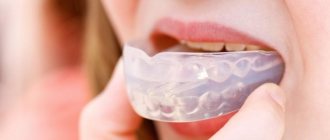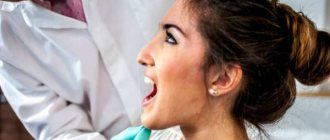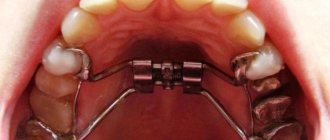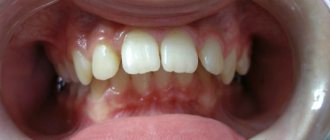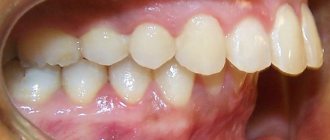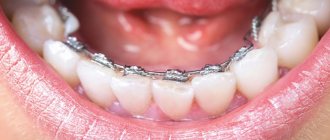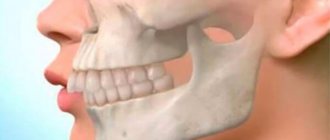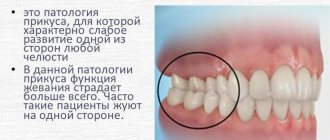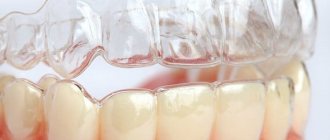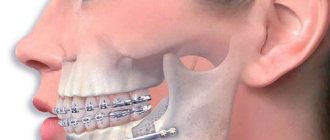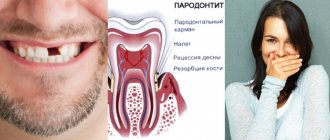4698
Trainers today are an excellent alternative to braces. They perform almost the same functions, but it is much easier to get used to them, since you can remove them periodically.
LM-Activator trainers can be used even before all teeth erupt , which greatly simplifies their alignment later.
Activator design features
Externally, the device resembles a mouthguard familiar to many, which protects boxers’ teeth from damage. The LM activator is made from special medical silicone. Due to the high elasticity of this material, patients quickly get used to the device.
In the front part of the rather high walls of the device there are special openings for breathing (their presence is especially important in the first stages of use, especially if the patient has difficulty breathing through the nose). The anterior group of teeth are located in special recesses while wearing the activator. This helps them maintain the correct position during treatment.
The activator is intended for teeth of both the upper and lower jaws, that is, it is double-jawed. While wearing it, your mouth should be closed and your teeth should be closed.
When is use recommended and contraindicated?
Doctors recommend using the LM activator for the following pathologies:
- close arrangement of the front incisors and canines , when the teeth sit closely and overlap each other;
- varying degrees of rotation (rotation, rotation of the tooth);
- deep bite (improper closure of teeth when the upper incisors overlap the lower ones);
- open bite (when there is no closure of the teeth, there is a vertical gap between the front or side teeth);
- cross bite (the teeth intersect chaotically when closing, due to the displacement of the jaw bones in relation to each other);
- distal bite (the front jaw is strongly advanced relative to the lower jaw);
- a gummy smile is characterized by a strong opening of the upper gum.
When the use of silicone mouthguard is prohibited:
- narrow upper dental arch;
- mesial bite (the lower jaw is pushed forward in a closed mouth position);
- the midline is shifted by more than 3 mm.
Types of activator
There are 2 main models of activators: low and high . The latter is used mainly for the treatment of open bites and has a thickening of silicone in the lateral areas (the area of the second premolars and molars). The low model has wider indications for use.
Both models are available in two types: short and long . The short model has a reduced size of the rear sections. It is used if the second molars (sevens) have not yet erupted.
In addition, different sizes of all the above models and their varieties are produced. The orthodontist determines the size required for the patient. To do this, appropriate calculations are made (based on the size of the front teeth), or a special line LM-OrthoSizer .
Make an appointment at the dental clinic
Treatment with LM-Activator
Treatment time
In most cases, it is recommended to begin treatment in the early mixed dentition before the eruption of the upper incisors.
The best results when correcting crossbite are achieved if treatment begins at the stage of teething. Active treatment
LM-Activator must be applied every night during sleep.
If treatment is started after the eruption of the upper permanent teeth in the anterior group, it is recommended to wear the LM-Activator for two hours during the day, in addition to wearing it at night. Daytime wear should continue until the malocclusion is corrected. The total time of daytime wearing can be divided into periods of 30 minutes (while watching TV, playing video games, or doing homework). The teeth must be tightly secured in the apparatus, the lips must be closed. Forceful biting, chewing, clenching or grinding of teeth can damage the appliance and should be avoided. A second appointment with your doctor should be scheduled 4-5 weeks after you start wearing it. Further appointments should be made every 10-12 weeks during the active wear phase. Retention period
The end of the active wearing phase depends on the individual characteristics of the patient.
In most cases, treatment can be completed when the lower canines are in the correct position and the lingual retainer can be secured to the lower arch. If the patient has prerequisites for retrusion or deep bite, night wear should be continued until the end of pubertal growth. During the retention period, you should visit your doctor every 6 months. Any orthodontic intervention must be based on an analysis of the dentofacial, skeletal and functional characteristics, as well as taking into account the individual growth characteristics of the patient to ensure appropriate and safe treatment. There are two models of LM-Activator - high and low
.
The low model
can be used for various pathologies.
Please use the reading table. There are two low model options available – Low Short and Low Long. Low short model – a model shortened in the molar area for patients whose second molars have not yet erupted. Supplied in a yellow container. Low Long Model – A model with an extended molar area for patients whose second molars have already erupted. Supplied in a blue container. The tall LM-Activator model
is thicker in the area of the second premolars and molars. The model is specially designed for the treatment of skeletal and dentofacial anomalies in open bites. High short model – a model shortened in the molar area for patients whose second molars have not yet erupted. Supplied in an orange container. The high long model is a model with an extended molar area for patients whose second molars have already erupted. Supplied in a green container.
Prices shown on the website may vary.
Please check with the managers for the exact cost and availability of goods.
Principle of operation
LM activator is used to correct orthodontic abnormalities. The principle of its operation is based on the direct mechanical alignment of teeth, as well as the establishment of the correct jaw relationship.
In addition, it helps to get rid of bad habits and normalize:
- breathing and swallowing functions;
- tongue position;
- tone of the maxillofacial muscles.
Often it is the violation of these functions or muscle tone, as well as various bad habits (biting nails, sucking fingers, etc.) that lead to the development of malocclusion. Therefore, correcting the bite without eliminating the cause of its appearance can provoke a relapse - and then the treatment will have to be repeated.
The LM activator helps eliminate not only the malocclusion itself, but also the causes of its occurrence. This minimizes the risk of relapse.
The device is also used as a prophylactic agent to prevent the development of orthodontic anomalies. This is especially true if you have bad habits or functional disorders. The device is also suitable for preventing the development of severe malocclusions.
What are they?
This is an orthodontic appliance that helps straighten teeth when they first begin to emerge . With the help of this design, the dentition becomes even, and the teeth are located in their places immediately after erupting from the gums.
It is also possible to use this device in a mixed bite, as soon as all the teeth have changed. The shape of the structure corresponds to ideal occlusion.
The model can be selected depending on the size of the jaw. The correctly selected size of the trainer allows you to simultaneously develop the dental arch while straightening your teeth. It can also be used to change your bite.
Design
All the advantages of the LM-Activator are manifested thanks to the design features :
- High walls and the presence of an edge help ensure that the device takes the correct position. This feature makes it possible to securely attach it to the lower jaw so that it can fully perform its functions.
- In several models, manufacturers have provided differences in thickness and length in the molar area, which makes it possible to use the device, adapting to the individual characteristics of the patient’s jaw.
The device is made of special medical silicone and has two jaws. Thanks to its elasticity, small patients do not experience significant discomfort while getting used to it.
Read about the rules for using orthodontic trainers for children in the following publication.
In a separate article we will look at why teeth grow crooked and how to prevent it.
At the link https://orto-info.ru/sistemyi-vyiravnivaniya-zubov/lechebno-profilakticheskie-apparatyi/treyneryi-myobrace.html we will tell you in what cases the Myobrace MB3 trainer is prescribed.
Who produces?
The devices are produced by the Finnish company LM-Instruments . They were developed jointly with the famous French orthodontist Daniel Rollet.
Since the late 80s of the last century, the company began producing high-quality devices for straightening teeth in children, which can be used immediately after the eruption of molars and molars.
Operating principle
The operating principle of the design depends on which model is used. If the child’s teeth have not yet erupted, a low model is selected for him.
The trainer is installed on the jaw, “enveloping” the teeth on several sides. In such a mouthguard, they immediately grow correctly, adapting to the direction and location.
The device helps to form proper breathing and swallowing, which has a beneficial effect on the development of facial and chewing muscles . The main design feature is the breathing holes, the presence of which is especially important for children with problems with the ENT organs.
When using the device, the jaws must be closed, which allows the teeth to be fixed in the correct position using special grooves and provides a therapeutic effect.
This is also a good way to get rid of bad habits if a child sucks his finger, bites his nails or chews his pen.
When is the device used?
Like any medical device, the LM activator has certain indications for use. Among them:
- malocclusion (open, deep, cross, distal bite);
- too close arrangement of teeth in the anterior group;
- reverse position of individual teeth;
- “gummy” smile;
- prevention of malocclusion.
Contraindications to the use of the activator include:
- too narrow upper dentition;
- mesial bite;
- too large (over 3 millimeters) displacement of the midline.
Practice has shown that the activator is most effective in mixed and primary occlusions. Application in the initial permanent dentition also shows good results. Due to the peculiarities of physiology in adults, the device is used quite rarely.
Experts who have been working with these devices for a long time have discovered that they can also be used in non-standard cases. For example, if necessary, additional elements can be introduced into the activator for a targeted effect on a specific tooth (or several teeth).
In adults, the device can be used to eliminate dysfunction of the temporomandibular joints, as well as if the hard tissues of the teeth have increased abrasion. It can also be used as a mouth guard for remineralization therapy, and in some cases as a retention device after orthodontic treatment.
Indications for use
The basis for making a decision to install an LM activator is the presence of one of the following medical indications:
- Diagnosis of bite deviations, with the exception of the mesial form of development;
- The need to correct a “gummy” smile;
- Need for correction of crowded and backward units.
It should be taken into account that the device is not used in cases where the patient has a midline displacement of more than three millimeters, and excessive narrowness of the upper dentition is also detected.
A distinctive feature of the structures is the possibility of multi-purpose use - if necessary, it is possible to introduce auxiliary elements into the apparatus that have an additional impact on individual units. In addition, silicone activators are successfully used as a basis for the procedure of remineralization of tooth enamel, whitening and restoration of row structure.
Advantages and disadvantages
The list of benefits noted by both dentists and patients includes:
- Efficiency of correction of defects in the development of bite;
- Aesthetics and ease of use of the device;
- Help in eliminating bad habits;
- Correction of not only the position of the jaws, but also diction.
The only disadvantage of the method can be considered the cost of the design - in order to buy an LM activator of a suitable size, you will need to allocate from 100 to 150 dollars. However, in comparison with braces used to solve similar orthodontic problems, the cost of the product seems quite acceptable for most patients.
Duration of treatment, how and how much to wear
The duration of correction depends on the defects requiring elimination, and is also determined by additional factors - from the age of the patient to the stage of formation of the bite. As a rule, a treatment cycle requires 1-2 activators, and from 12 to 24 months. The device is used primarily at night - daytime wearing is limited to two hours, which avoids aesthetic problems and inconvenience in communicating with others.
How and how long should you wear the LM activator?
The need, frequency and duration of wearing in each specific case is determined by the attending orthodontist. It is usually recommended to wear the device at night and during the day for two hours. In this case, daytime wearing can be divided into shorter periods of time. It is important that in total they give the required two hours.
In some cases, only overnight wear is sufficient, and sometimes longer daytime wear is required.
In any case, the entire time you wear the activator, you must ensure that your teeth are firmly fixed in it and your lips are closed. Do not chew or bite hard on the device as this may cause mechanical damage. In this case, the device will have to be replaced.
Caring for the device is quite simple. In the dental clinic it is disinfected by autoclaving. At home, it is enough to clean the activator with toothpaste using a regular toothbrush and periodically disinfect it by boiling.
Advantages and disadvantages
Correcting malocclusion and other pathologies using an activator has several important advantages that distinguish it from other devices. Let's look at the main ones.
- Successfully used to correct bite.
- It has clear aesthetic advantages over braces.
- Simple and easy to use.
- Helps cope with bad habits that have a detrimental effect on the formation of the bite - finger sucking, nail biting.
- Simultaneously with bite correction, it eliminates diction defects.
- Increases the tone of the orbicularis oris muscle.
- Low price compared to braces.
DETAILS: What can you eat while wearing braces?
Where can I buy an LM activator?
You can purchase this orthodontic device on the recommendation of your attending physician at Media LLC. We offer a wide selection of all models of LM activators (high short, high long, low short and low long) in various sizes.
The devices offered by Media LLC have a shape that corresponds to ideal occlusion. 37 combinations of sizes and models allow you to select the activator suitable for each individual patient, without the need for individual modifications. All activators are supplied in individual containers. The color of the container corresponds to the device model.
Remember that you should not self-medicate and choose an activator without consulting a specialist. Only a qualified orthodontist can correctly determine which LM activator you should buy. Otherwise, you may not only not get rid of the problem, but also make it worse.
Installation and treatment with a corrective device
Like any medical device, the LM activator has certain indications for use. Among them:
- malocclusion (open, deep, cross, distal bite);
- too close arrangement of teeth in the anterior group;
- reverse position of individual teeth;
- “gummy” smile;
- prevention of malocclusion.
Contraindications to the use of the activator include:
- too narrow upper dentition;
- mesial bite;
- too large (over 3 millimeters) displacement of the midline.
Practice has shown that the activator is most effective in mixed and primary occlusions. Application in the initial permanent dentition also shows good results. Due to the peculiarities of physiology in adults, the device is used quite rarely.
Experts who have been working with these devices for a long time have discovered that they can also be used in non-standard cases. For example, if necessary, additional elements can be introduced into the activator for a targeted effect on a specific tooth (or several teeth).
In adults, the device can be used to eliminate dysfunction of the temporomandibular joints, as well as if the hard tissues of the teeth have increased abrasion. It can also be used as a mouth guard for remineralization therapy, and in some cases as a retention device after orthodontic treatment.
Since the installation of the LM activator is not permanent, its preliminary fixation takes place in our clinic, after which the structure is removed. We will give you valuable instructions regarding the use of the product, as well as schedule a visit to monitor the progress of treatment.
The LM activator has 37 different models in its line with optional length and thickness of the product in the fixation zone. This variety will help our orthodontist choose the ideal trainer option for the child, which fully matches the structural features of his jaw. The device can be worn on both the upper and lower jaw. The specific treatment plan depends on the complexity of the original case.
If you are worried about your child’s pain, we hasten to assure you that he will not feel any discomfort. The elasticity of the material from which the device is made quickly adapts to the parameters of the jaw and does not cause pain to the patient. This also adds advantages to the trainer over conventional metal braces.
You must pay attention to some nuances of wearing the device. The child's teeth should be tightly closed and the mouth closed. Intense biting, chewing, grinding or clenching of teeth may damage the product. A second appointment with our specialist should take place after 4-5 weeks of constant wearing of the LM activator. Follow-up visits should occur at 10-12 week intervals until orthodontic treatment is completely completed.
During follow-up consultations, our dentist may cancel additional daily wear, or perhaps increase its duration. It all depends on the complexity of the case and the dynamics of treatment.
The entire process of correcting the bite, as a rule, takes no more than 1-1.5 years. However, the correction period may be delayed, depending on the patient’s age, as well as the type and degree of the specific pathology.
At one of the control appointments, our specialist can make changes to the design of the trainer using a silicone drill, scissors or a scalpel. Typically, these manipulations are performed when the bite changes during treatment, but they may also be appropriate in an emergency. If your child complains of too much pressure on soft tissue, contact us immediately and we will quickly resolve the problem.
Caring for the device
The LM activator must be constantly cleaned and disinfected. They can be produced in an autoclave at a temperature of 134 degrees Celsius. At home, disinfection should be carried out by boiling. Also, the patient (or his relatives) should regularly clean the device with a toothbrush. In this case, you can use antibacterial solutions and toothpastes.
There are no absolute contraindications to wearing the device. However, in some cases its use is inappropriate and impractical.
The trainer is not used when:
- Displacement of the midline of the jaw by 3 mm or more;
- Extremely narrow frontal dentition;
- Mesial occlusion.
DETAILS: Are braces used on crowns and teeth with fillings? — About bite correction and braces
For adult patients with mature teeth, wearing a LM activator is indicated in exceptional cases.
Today, everyone has access to online markets with an abundance of various medical products. LM-activator is no exception - any parent can purchase it without leaving home.
However, there is no need to do this, since you risk not only not getting results, but also harming your baby. When selecting a specific shape and size of a trainer, it is important to take into account the presence of crowding or diastema of certain teeth. Depending on the pathology, these parameters must be adjusted, even if they correspond to the results of the initial measurements.
When trying on the structure, it is important to make sure that the teeth are in the correct position - otherwise, the treatment will not give any results. And finally, the device model can optionally change during the treatment process. You will not be able to cope with all these tasks on your own. Of course, unless you are an orthodontist yourself.
Do you want your child to smile at the dentist's appointment? Then we invite you to a consultation at our Alfa-Dent clinic! Our professionals will select the optimal treatment regimen, carry it out painlessly, comfortably and with guaranteed quality. Call us and make an appointment!
Activator
The activator is a removable plate device that covers the mucous membrane of the hard palate, the oral surface of all teeth of the upper and lower jaws, as well as the mucous membrane of the alveolar processes on the inside.
The bed for each tooth forms an inclined plane along which it can be moved forward, backward or to the side. The teeth do not come into contact with the plate with their entire internal surface, but only in certain areas. On the side where the tooth should move, the plastic in the plate is ground off. If, for example, it is necessary to move the teeth of the upper jaw to the distal side, then they touch the plate only with their mesial surfaces, and on the distal side of these teeth the plastic is cut out for unhindered movement of these teeth backwards.
If it is necessary to move the same teeth forward, the plastic is cut out from the mesial side. During orthodontic treatment, it is sometimes necessary to simultaneously move teeth in different directions. In such cases, the bed for the teeth is cut out accordingly. Using the activator, you can also move the entire lower jaw in the desired direction.
In addition to inclined planes, the activator may contain various elements of mechanical devices, namely: a Cofin spring, an expanding screw, a vestibular wire arch, etc. The activator is used only at night, and is removed during the day. Correction of dentofacial deformities using this device is carried out over a long period. The best results are achieved in early childhood.
At an older age and with pronounced deformations, the use of an activator does not always lead to the desired results. Subsequently, various modifications of the Andresen activator were proposed.
“Childhood Dentistry”, A.A. Kolesov
Functional Frenkel regulator
The functional Frenkel regulator consists of lateral and vestibular pellets located in the vestibule of the oral cavity in the area of the lateral and anterior teeth. They relieve the dentition from the pressure of the cheeks and lips and create conditions for normal jaw growth in the transversal and sagittal directions. In addition to these pilots, the device contains elements of mechanical devices in the form of a spring for moving teeth....
Structural changes in the dental system during orthodontic treatment
Orthodontic treatment of dentofacial deformities is based on changing the mechanical and functional load on various parts of the dentofacial system. It is achieved with the help of myogymnastic exercises or the use of orthodontic appliances. Under the influence of a changed load, tissue restructuring occurs, as a result of which it becomes possible to correct the deformity. The latter involves the movement of the teeth and lower jaw in different directions, as well as the expansion of the dental...
The severity of tissue changes
Based on the severity of morphological changes in the periodontium, D. A. Kalvelis divides them into four groups. It has been established that when using mechanical and functional orthodontic appliances, the morphological changes in the periodontium are basically identical. S. S. Raizman, based on his research, advocated lengthening the treatment period and believes that the intermittent power of the device has an advantage over the continuous one. Significant applied…
Histological changes in the periodontium during horizontal tooth movement
There are two types of horizontal tooth movement: corpus and inclined. Body movement is carried out by special designs of orthodontic devices and is characterized by the fact that the crown and root of the tooth move in the same direction without tilting in any direction. When a tooth moves in an oblique manner, its crown, together with most of the root, moves in the direction of the acting force...
Moving teeth to the vestibular or oral side
When teeth are moved to the vestibular (labial, buccal) or oral (lingual, palatal) side, bone tissue resorption on the pressure side (on the side where the tooth moves) occurs only on the inner surface of the socket, in the cervical and middle thirds of it. On the outer, i.e. gingival, surface of the same wall of the socket, the formation of bone tissue is observed. This compensatory bone building on...
